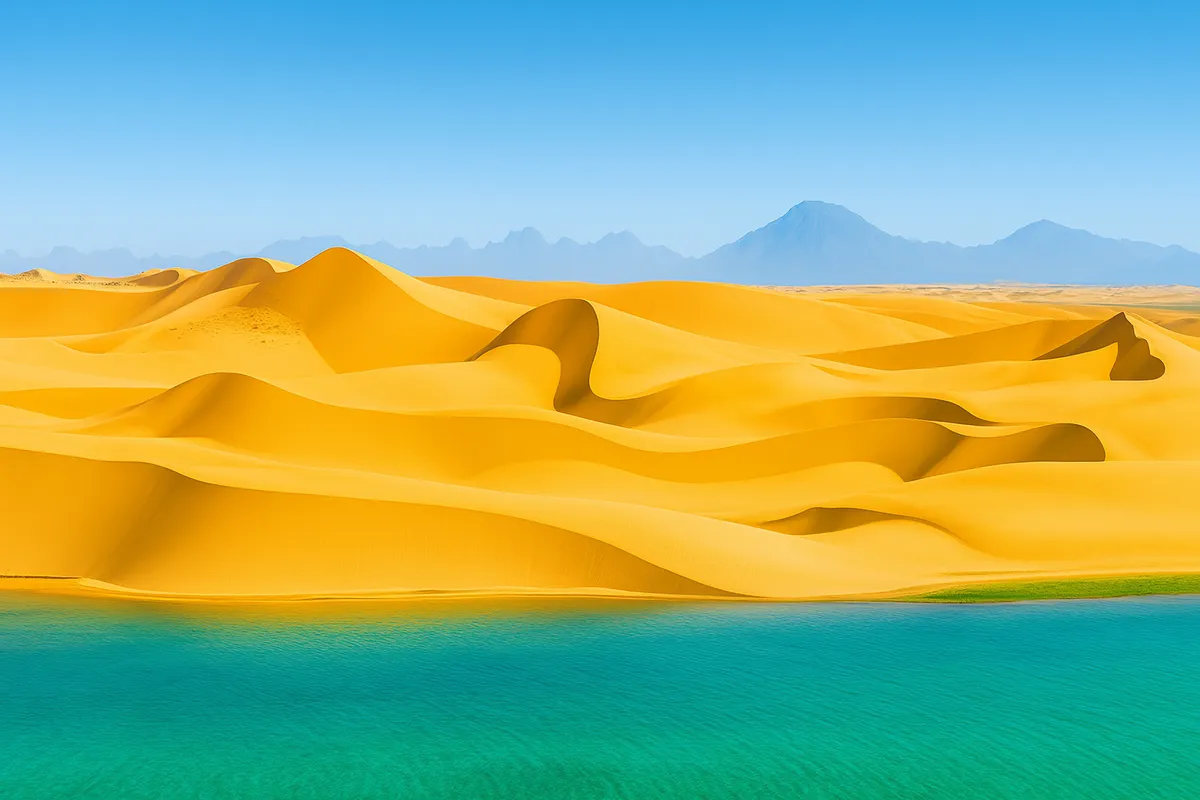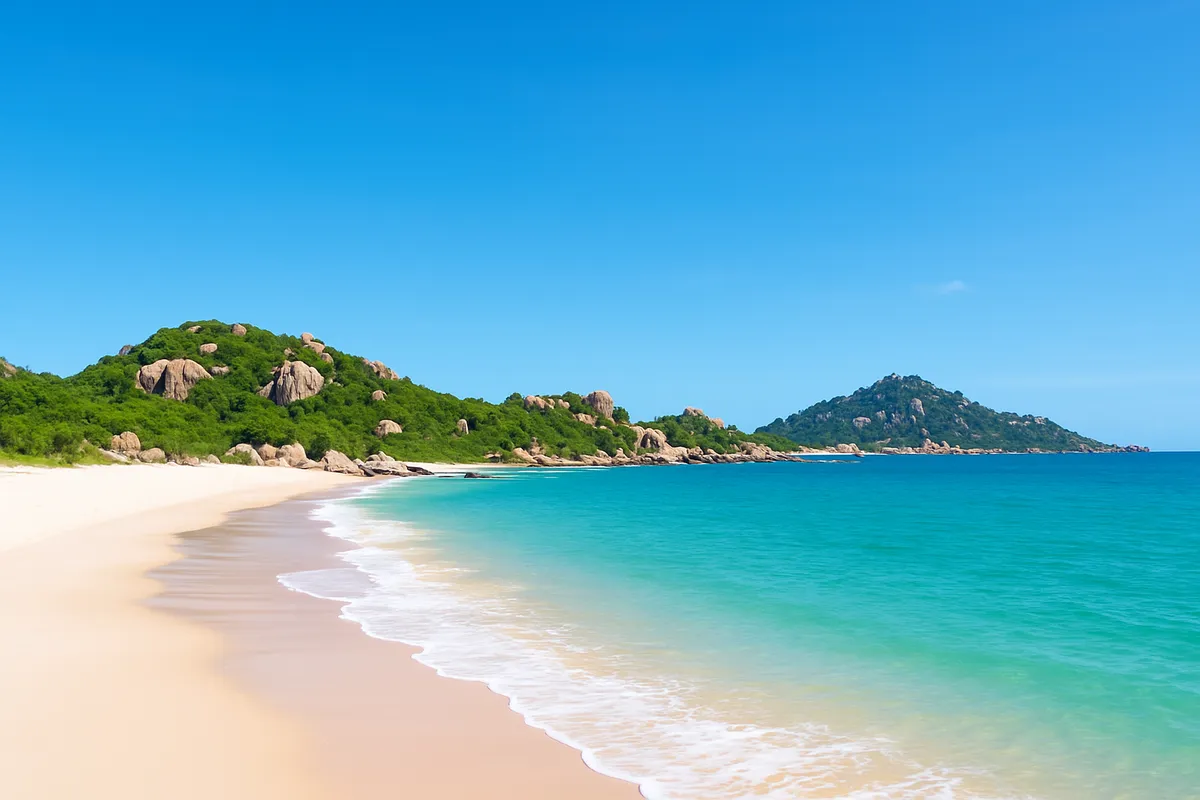Mui Ne Flying Sand Dunes and the Legend of Breathing Sand
- Saturday, Jun 28, 2025, 06:40 (GMT+7)
Mui Ne Flying Sand Dunes and the Legend of Breathing Sand
The Mui Ne Flying Sand Dunes appear like a shimmering mirage along Vietnam’s southeastern coast, where sunlight does not simply shine but paints the earth in motion. From the first step on this vast sandy terrain, time seems to soften. Each grain of sand glows under the sun as if nature has gently brushed blush across the earth’s surface. Footprints vanish in moments, erased by the wind, leaving behind only the trace of presence. The name "Flying Sand Dunes" is not poetic exaggeration. It is a natural phenomenon where sand is lifted and reshaped by wind, forming new contours each hour without warning.
Situated about 25 kilometers from the center of Phan Thiet, near the coast of Hon Rom, these dunes create a world apart. Here, nature becomes an artist without limits. In early morning, the sand carries a soft purple tint, holding on to the last breath of night. As the sun rises, the colors shift into golden yellows and deep ochres that ripple under the light. By late afternoon, the entire landscape is bathed in a warm orange tone, and the shadows fall gently along the curved ridges.
It is said that if one stands still in this place, the wind seems to speak to the sand. Not in words, but in tones that rise and fall like a hidden melody. From time to time, the wind sweeps across the surface, lifting fine sand into swirls that move like petals caught in an invisible current. Within this movement lies a silence that is not empty, but full of presence and awareness. Every sound becomes more vivid, every breath more grounded.
Local legend speaks of an ancient people who once believed that the dunes were sacred ground. They saw it as a threshold between the living world and the realm of spirits. Each grain of sand was believed to hold a memory carried by the wind. While historical records offer little proof, the story lingers, and those who come here often feel an inexplicable connection to something older than memory.
In 1995, thousands gathered on these dunes to witness a total solar eclipse. The sky dimmed, shadows lengthened, and the sand responded with a quiet glow. It was a moment when light and darkness met on the same canvas. Since then, Mui Ne has remained a name whispered among travelers in search of wonder. The event marked a turning point, when this landscape stepped from the unknown into the collective imagination of a generation.
A short walk away from the dunes, Bau Trang awaits like a hidden oasis. Known also as the White Lake, it stretches silently across the horizon with calm freshwater and blooming lotuses. The contrast is surreal. From the sunburnt sand, one moves into a scene of still water and delicate petals. Travelers have likened it to a miniature desert beside a freshwater dream. There is no need for grandeur here. The harmony between sand and water speaks for itself.
The soft pink and golden tones of the sand are shaped not only by light but also by time. Scientists have discovered that the color comes from iron-rich deposits left in ancient sediment layers. This has given Mui Ne a natural palette that is rarely seen elsewhere. The sand is not only beautiful but also carries the story of the earth’s deep past.
Remarkably, despite its fame, the Mui Ne dunes have not been overtaken by heavy tourism infrastructure. There are no paved walkways, no railings, no rooftops. Just the elements and the visitor. This allows every experience to remain personal and authentic. Some bring sandboards to glide down the slopes. Others simply walk barefoot, letting the fine grains slide between their toes, letting the wind write its message across their skin.
The best months to visit are between September and April, when the skies are clear and the air is dry. Early mornings are the most rewarding. The sand is cool and unmarked, the breeze carries the scent of distant tides, and the colors shift with every passing minute. One does not rush in this place. Time bends gently, offering quiet moments for reflection and wonder.
The journey to the dunes is an experience in itself. From Phan Thiet, a ride along the coastal road opens up panoramic views of sea cliffs, sun-warmed fields, and sleepy fishing villages. As one approaches the dunes, the scenery shifts from green to gold. The road narrows, and suddenly, there is only wind and sand ahead.
By late afternoon, local snacks offer simple pleasures. Freshly grilled rice cakes, sugarcane juice crushed by hand, and chilled seaweed drinks served in plastic cups become small gifts to the senses. The flavors are humble, yet against the backdrop of golden light and shifting sand, they taste like memories in the making.
Visitors are advised to bring sunglasses, wide hats, and protective lotion. The wind is often playful, carrying grains high into the air. But this is not a nuisance. It is part of the experience. The sand clings to shoes and clothes as a reminder that this place does not easily let go. It stays with you, even after you leave.
A special quiet settles over the dunes just before sunset. The wind softens, and the light fades into deeper hues. The ridges cast long shadows, and the sand no longer dances. It breathes. It waits. This is the moment when the landscape becomes more than beautiful. It becomes sacred. Not because of legend, but because of feeling.
Among the many destinations built for spectacle and speed, Mui Ne remains a place for presence. It asks nothing from the visitor except attention. There is no performance here, no itinerary to follow. Only space. Only breath. Only sand and sky and silence.
For those seeking something raw and real, something that speaks to a deeper rhythm, the Mui Ne Flying Sand Dunes remain a quiet invitation. To pause. To listen. To feel the world move beneath your feet. And to know, if only for a while, what it means to stand inside the breath of the earth.

 CHECKIN.VN
CHECKIN.VN








Share on